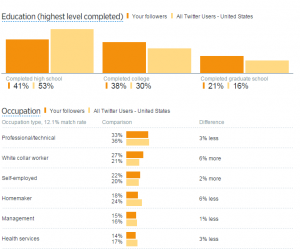Twitter recently made a big splash in the social media world when they announced their new analytics – called audience insights. If the name sounds familiar, it should since it is something that Facebook has shared with marketers for years. While it would be easy to jump into the fray and replace Facebook for Simpsons in the old “Simpsons did it” meme, I won’t.
Sure Twitter is late to the party, but at the same time they have made some advancements that Facebook can’t get to due to their privacy policy. What I like about the new analytics is that it will allow users to track their personal performance (if they have goals associated – thought leadership, eyeballs, etc.) or to see who on their network is truly engaged with them. There is a mix of vanity in both of those two points, but it also plays to the vanity of social networking platforms.
From the business end, I think that these new metrics could really offer some real benefits from a paid and earned media perspective. Below are some areas that I feel could really be game changers for Twitter in regards to how businesses are looking at them as a platform.
Community Management: One of the underlying thoughts that are traditionally tied to Twitter (rightly or wrongly) is that it is a truly customer service channel. While there are definitely a lot of arguments for that, I think that looking at the main tab of the audience insights, you can see what Tweets that included you garnered the most engagements. In the image below, I can see that my Tweet, shared by Amy Brock generated a few actions. If I were a business looking at this dashboard, I would take this and see if I could leverage surprise and delight by sending her something nice as a thank you from my business. I would also look at the Top Follower area to see if the person was worth trying to engage with to help with my thought leadership within the space.
Eyeballs translating to actions: While we can opine all we want on social media being a conversational tool, it is also Big Business. The conversations are truly valuable, but when you talk to a CMO or marketing VP, numbers are probably more valuable. A common question asked is what are these tweets generating? How many people are seeing them? And how does this help my bottom line? In looking at the Tweet summary (image above) you will see some impression numbers. If you are driving traffic back to your site, you can tie value back by leveraging other tools like their conversion tracking pixel – Twitter Cards can also be used for this type of tracking. This mixing of products is something that most social media managers should be familiar with from Facebook. Tracking the impressions and clicks will really help answer that executive-level question better than saying “but we had 2,000 conversations and 1,000 new followers.”
Research: One of the things that made me chortle a bit when seeing Audience Insights was the ability to look at and compare demographics vs. that of Twitter’s universe. The thing that stood out was that this was something that I have used with FB for years – while it isn’t as robust, it does give a comparison point. Many social media managers will discredit a platform or network because you can’t get real data or “my customers aren’t there.” The later often comes in taking industry reports as gospel and not in primary data points. With Twitter showing the demographical data, social media professionals can now make educated decisions in regards to resources allocated to Twitter in regards to media spend and content marketing. If your audience is not matching that of your primary customer, do you need to pivot or abandon the network? Comparing demographics to that of Facebook, you will be able to see if you are talking to the right people. You can also see how these demographics change over time and if ads or content help to shift that.
compare demographics vs. that of Twitter’s universe. The thing that stood out was that this was something that I have used with FB for years – while it isn’t as robust, it does give a comparison point. Many social media managers will discredit a platform or network because you can’t get real data or “my customers aren’t there.” The later often comes in taking industry reports as gospel and not in primary data points. With Twitter showing the demographical data, social media professionals can now make educated decisions in regards to resources allocated to Twitter in regards to media spend and content marketing. If your audience is not matching that of your primary customer, do you need to pivot or abandon the network? Comparing demographics to that of Facebook, you will be able to see if you are talking to the right people. You can also see how these demographics change over time and if ads or content help to shift that.
At the end of the day, I hope that Twitter continues to invest in their reporting features to users. It is something that is needed for social departments to continue to grow. I personally look forward to the day where they help close the parity gap in the social realm, how about you?

